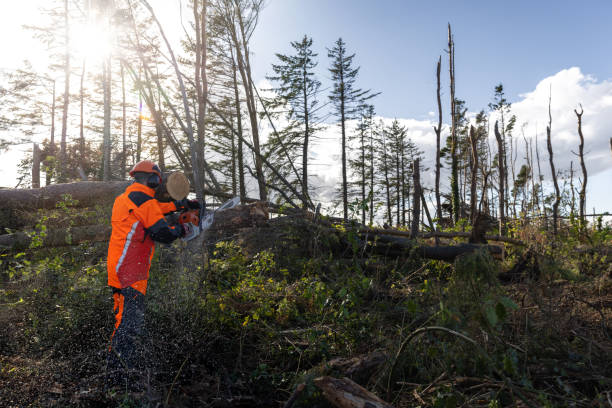When you think about maintaining your outdoor spaces, tree removal might not be the first task that comes to mind.
However, it’s a crucial part of landscape management that shouldn’t be overlooked.
Removing trees—especially those that are diseased or pose safety hazards—not only safeguards your property but also opens up opportunities to improve the overall look of your surroundings.
But how do you determine which trees should be removed and which should remain?
It’s a delicate balance that requires thoughtful consideration of the immediate and long-term effects on your landscape.
Let’s dive into the factors that influence these important decisions.
(h2) Identifying Reasons for Tree Removal
When faced with the decision to remove a tree from your landscape, it’s essential to consider the underlying reasons carefully.
Here are some key factors to evaluate:
(h3) Safety Concerns
- Leaning trunks: These can pose a significant risk of falling, especially during storms.
- Hollow limbs: Hollow areas can weaken the tree’s structure and increase the risk of breakage.
- Extensive deadwood: Dead branches can snap off and cause damage or injury.
(h3) Disease Management
- Infected trees: Trees suffering from diseases like Dutch elm disease or the emerald ash borer can spread the infection to nearby healthy trees.
- Prevention: Removing infected trees early can help prevent further damage to your landscape.
(h3) Root System Issues
- Foundation damage: Roots can cause structural damage to buildings or sidewalks.
- Pipe interference: Roots can clog or damage underground pipes.
(h3) Growth Problems
- Space constraints: Trees too large for their location can obstruct views or interfere with other plants.
- Long-term growth: Consider the tree’s future size and growth patterns to determine if it will continue to fit into your landscape.
(h3) Additional Considerations
- Property value: Removing a tree may affect your property’s overall value.
- Environmental impact: Consider the ecological benefits of the tree and any potential negative consequences of removal.
- Local regulations: Check with your local authorities for any permits or restrictions regarding tree removal.
You can decide whether to remove a tree from your landscape by carefully evaluating these factors.
(h2) Impact on Landscape Aesthetics
When considering tree removal, it’s crucial to evaluate how it will affect the overall aesthetic appeal of your landscape.
Trees play a significant role in creating a visually pleasing and harmonious outdoor space.
(h3) Here are some key considerations:
- Structural component: Trees provide a structural framework that can be difficult to replace. Their absence can leave a void in the landscape.
- Visual balance: Trees can help balance a landscape’s overall composition. Removing a tree can disrupt this balance.
- Shade and privacy: Trees offer shade and privacy, which can be missed after removal.
- Texture and color: Trees add variety to a landscape with different textures and colors throughout the year.
- Opportunity for redesign: Tree removal can provide an opportunity to rethink the landscape design and create a more aesthetically pleasing space.
While removing a tree can negatively impact the aesthetics of your landscape, it’s important to consider the long-term benefits.
You can create a functional and visually appealing space by carefully planning and redesigning.
(h2) Safety and Liability Considerations
When considering tree removal, it’s crucial to prioritize safety and liability concerns:
(h3) Safety
- Professional removal: Hire qualified professionals with experience in tree removal to minimize the risk of accidents.
- Personal safety: Avoid attempting to remove trees yourself, as it can be dangerous and lead to injuries.
- Property damage: Improper tree removal can cause damage to your property or nearby structures.
- Falling objects: Be aware of the potential for falling branches or debris during removal.
- Utility lines: Ensure the tree is not near any power or other cables.
(h3) Liability
- Property damage: You may be liable for any damages caused by a falling tree, such as damage to neighboring properties or vehicles.
- Personal injury: You could face significant legal consequences if a falling tree injures someone.
- Insurance coverage: Ensure adequate insurance coverage to protect yourself from potential liabilities.
- Contractor insurance: Verify that your hired contractor has the necessary insurance coverage.
(h3) Legal Considerations
- Local regulations: Check with your local authorities to determine if the tree is protected under conservation laws or zoning ordinances.
- Permits: Obtain the required permits before proceeding with tree removal.
- Easements: Be aware of any easements affecting the tree or its removal.
(h3) Additional Considerations:
- Environmental impact: Consider the environmental impact of tree removal, especially if the tree is a native species or provides habitat for wildlife.
- Community concerns: If the tree is a significant landmark or part of its heritage, be aware of potential opposition to its removal.
Addressing these safety and liability concerns ensures the tree removal process is conducted safely and responsibly, protecting yourself, your property, and the environment.
Tree removal is a critical part of landscape management that should not be taken lightly.
By carefully assessing the reasons for removal, the impact on your landscape’s aesthetics, and the safety and liability concerns involved, you can make informed decisions that protect your property and its long-term beauty.
While removing a tree may seem like a loss at first, it can open up opportunities for redesign and improvement, leading to a healthier and more visually appealing outdoor space.
Always seek professional help to ensure the job is done safely and effectively.

